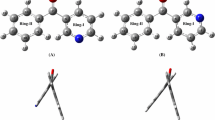Abstract
A comprehensive study of acridine spectra with variation of pH, wave length of excitation, deuteration of the solvent, etc., has been made. The excited state protonation of acridine is found extra-ordinarily excitation wavelength sensitive near the red edge of the first absorption band. The proton association takes place very fast (K PT ~ 1010 sec-1) on excitation at the red edge of the first absorption band (ree) and acridinium emission is observed while it is slow on short wavelength excitation (swe). The reaction rate slows down at lower temperature which is indicated by a delay in the initiation of the effect by ~ 8 nm on ree. The acridinium type emission with ree at 80 K shows that proton tunnelling is the chief mechanism of proton transfer. The quantum yields are also found wavelength dependent. Contrary to previous observations acridinium ion also shows a ree shift at 80 K.
Similar content being viewed by others
References
Avouris P, Gelbart W M and El-Sayed M A 1977Chem. Rev. 77 793
Chen R F 1967Anal. Biochem. 19 374
Fletcher N 1968J. Phys. Chem. 72 742
Freed K F 1976Top. Appl. Phys. 15 (ed.) F K Fong p. 168
Gangola P, Joshi N B and Pant D D 1977Chem. Phys. Lett. 51 144
Gangola, P, Joshi N B and Pant D D 1979Chem. Phys. Lett. 60 329
Itoh K and Azumi T 1975J. Chem. Phys. 62 3431
Jacon M, Lardeaux C, Lopez-Delgado R and Tramer A 1977Chem. Phys. 24 145
Kellmann A 1977J. Phys. Chem. 81 1195
Landner S J and Becker R S 1963J. Phys. Chem. 67 2481
Lowdin O P 1965Adv. Quantum Chem. 2 213
Mataga N, Kaifu Y and Koizumi M 1956Bull. Chem. Soc. Jpn. 29 373
Mataga N, Kaifu Y and Koizumi M 1957Bull. Chem. Soc. Jpn. 30 368
Pande U, Joshi N B and Pant D D 1980Chem. Phys. Lett. 72 209
Rice S A 1974Excited states 2 (ed.) E C Lim (New York: Academic Press) p. 232
Rudik K I and Pikulik L G 1971Opt. Spectrosc. 30 147
Shah J, Joshi N B and Pant D D 1980Curr. Sci. 49 609
Shapiro S L and Winn K R 1980J. Chem. Phys. 73 5958
Valeur B and Weber G 1978J. Chem. Phys. 69 2393
Weber G 1960Biochem. J. 76 335
Weber G and Shinitzky M 1970Proc. Natl. Acad. Sci. (USA.) 65 823
Weller A 1957Z. Electrochem. 61 956
Whitten D G and Lee Y J 1971J. Am. Chem. Soc. 93 961
Zundal G 1976The hydrogen bond II (eds.) P Schuster, G Zundal and C Sandorfy (Amsterdam: North Holland Pub. Co.) p. 283
Author information
Authors and Affiliations
Rights and permissions
About this article
Cite this article
Gangola, P., Joshi, N.B. & Pant, D.D. Red edge excitation and proton association in the excited state of acridine. Proc. Indian Acad. Sci. (Chem. Sci.) 91, 229–239 (1982). https://doi.org/10.1007/BF02845022
Received:
Revised:
Issue Date:
DOI: https://doi.org/10.1007/BF02845022




